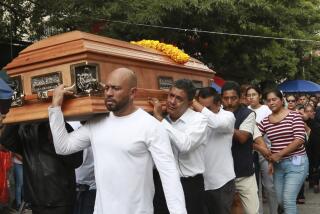Nicaragua’s Hostage Crisis: Old Hatreds Still Run Deep : Latin America: For Contras and Sandinistas, civil war never ended. Cardinal Obando y Bravo agrees to intercede.
- Share via
MANAGUA, Nicaragua — One became a Sandinista guerrilla at the age of 16 and still calls himself a revolutionary, fighting for a revolution he sees as fading. The other also joined the Sandinista Front as a youth but, like so many peasants, became disillusioned and then angry. He turned to the enemy, the Contra rebels, who fought the Sandinistas throughout the last decade.
The two men who have held Nicaragua hostage for the last several days embody the two distant sides of a civil war that is still being waged three years after a formal peace agreement ended the fighting but settled little.
To this day, the polarization and hatreds continue to run so deep that when the wives of conservative politicians being held hostage met Monday with President Violeta Barrios de Chamorro, the wife of hostage Alfredo Cesar refused to participate. Cesar is one of Chamorro’s harshest critics and a bitter enemy of Chamorro’s chief of staff, Antonio Lacayo, whose removal the right is demanding.
And, making this even more of a truly Nicaraguan story, Cesar’s wife is Lacayo’s sister.
Jose Angel Talavera, alias The Jackal, and his band of rearmed Contras continued to hold 18 mostly Sandinista hostages in northern Nicaragua on Monday after releasing 20 Sunday night. Donald Mendoza, alias Comandante 31, and his band of former Sandinista soldiers continued to hold right-wing Vice President Virgilio Godoy and 22 other politicians and journalists captive in Managua.
Mendoza, who seized his hostages in an effort to force Talavera to free his, released four people Monday after letting two go Sunday for “humanitarian” reasons, including poor health.
In a sign that negotiations were stagnating, a government-appointed team of mediators, including Sandinista and conservative representatives, on Monday turned to Cardinal Miguel Obando y Bravo for help. Obando y Bravo, after resisting for several days, agreed to intercede and planned to travel to Talavera’s northern hide-out today, officials announced.
As he has since first taking his hostages last Thursday, Talavera continued to demand the removal of Lacayo and Defense Minister Humberto Ortega, the brother of former Sandinista President Daniel Ortega. For the rearmed Contras, the two men represent continued Sandinista influence in Chamorro’s government.
Chamorro’s upset victory over the Sandinista Front in 1990 elections brought a formal end to the war. But hundreds of former combatants from both sides have taken up guns again to pressure the government to fulfill its promises of land, money and other aid.
Based on interviews with Organization of American States peacekeepers, former rebels, government officials and the two men themselves, a portrait of Talavera and Mendoza emerges. On paper, their backgrounds bear similarities. But their differences and their hatred open a possibly insurmountable gulf between them.
Talavera gained recognition earlier this year as the most effective commander of rearmed former Contras. He leads 400 to 800 men in the rugged mountains north of Quilali near Nicaragua’s border with Honduras, land of his birth.
Talavera, now 32, joined the Sandinista fight as a youth to oust dictator Anastasio Somoza in the 1970s. He returned to the north after the Sandinista triumph in 1979 but soon tired of what many peasants saw as arbitrary Sandinista policies that forced them into cooperatives and slapped controls on the market where they sold their beans and cattle.
As the United States began organizing and financing Contra rebels to challenge Sandinista rule, Talavera found a new cause. He joined the Contras in 1985, received training at Ft. Bragg, lost a leg when he stepped on a land mine a couple of years later and received an artificial limb in Miami. At the war’s end in 1990, he returned to a rice farm he purchased near the central city of Leon.
Not even a year later, a group of Sandinista squatters occupied his farm and threatened to kill him if he didn’t leave. Talavera returned to the hills and the gun.
“We only have weapons to pressure the government to fulfill what the people of Nicaragua were promised, what they voted for, what they struggled for in the last decade,” Talavera, whose father was killed in a Sandinista ambush during the war, told reporters last month.
Like Talavera, Mendoza is of peasant stock. He was 16 when he joined the clandestine Sandinista underground in the 1970s and was formally incorporated into the Sandinista People’s Army after the 1979 insurrection. He rose to the rank of major and served as a military attache to the Sandinista Nicaraguan Embassy in Washington in 1980.
Mendoza belonged to the most hard-line faction of the Sandinista Front affiliated with former Interior Minister Tomas Borge.
When the war ended and the Soviet Union, traditional backers of the Sandinista Front, collapsed, the army was reduced; about 20,000 officers, including Mendoza, were dismissed. Last year, he formed a veterans association that some people accuse of secretly maintaining weapons.
Mendoza said this week that he fears the “accomplishments” of the Sandinista revolution are being destroyed.
“The Jackal and his people hate the Sandinistas,” he said. “It’s politics, but it’s more than politics. It’s hate. They want the Sandinistas to disappear.”
In Washington, State Department spokesman Mike McCurry said the skill with which the Chamorro government handles the crisis will be a factor in determining whether Washington will resume economic aid to Managua.
“Unless Nicaragua obtains control over the security services, additional progress will be hard to achieve,” McCurry said.
Other U.S. officials said that the ouster of Humberto Ortega from his post as army chief is a minimum requirement for resumption of aid.
More to Read
Sign up for Essential California
The most important California stories and recommendations in your inbox every morning.
You may occasionally receive promotional content from the Los Angeles Times.














